Ever since I started Art Class Curator in 2014, I’ve heard a lot of teachers who haven’t tried our lessons tell me that their students can’t do them. They think the lessons are too high-level or their students won’t connect with the works of art. Oh how wrong they are! So today I want to focus on destroying the big myth that can cause you to underestimate your students and believe that they can’t handle higher level thinking and gain a deeper connection with art in the classroom.
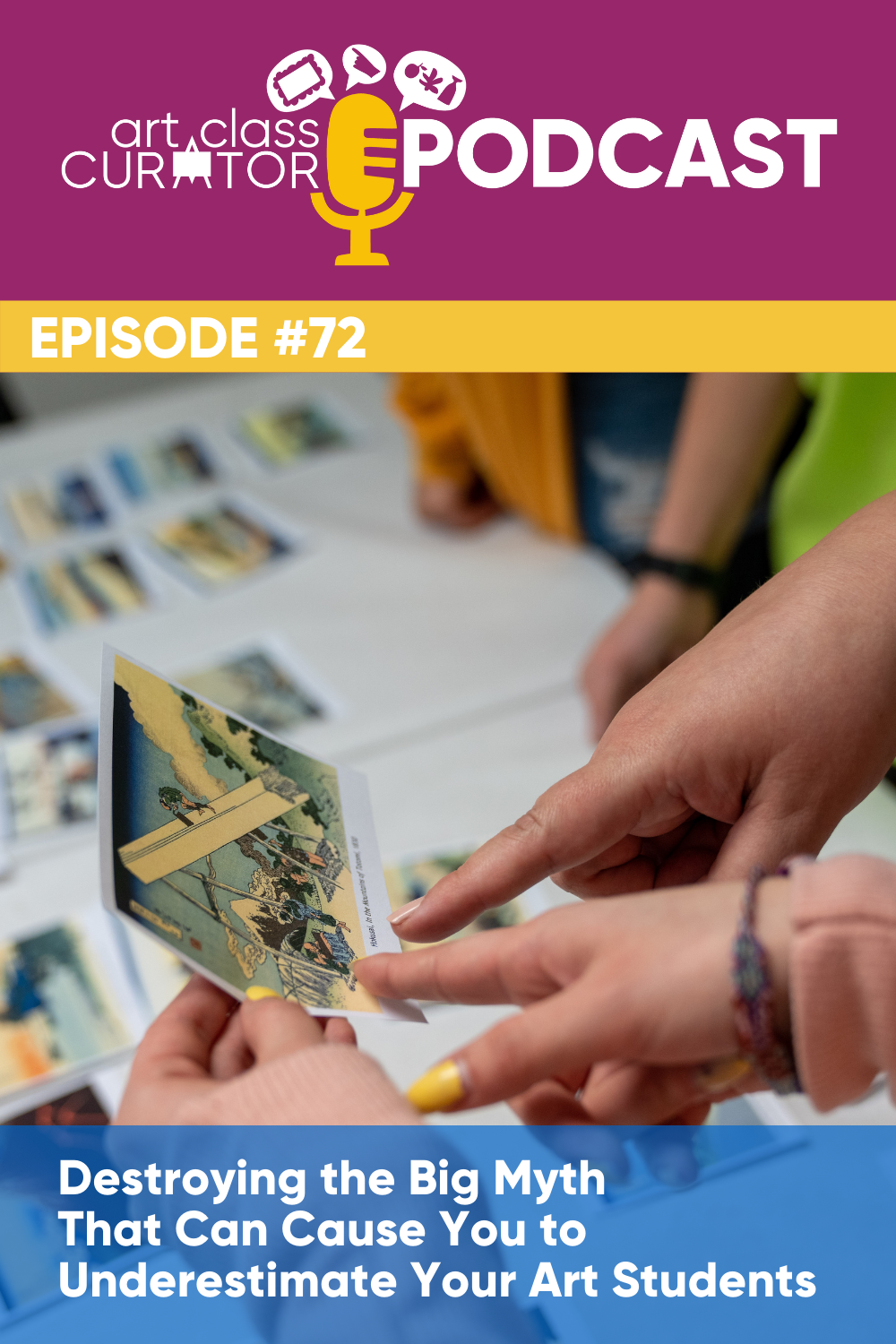
8:18 – The only difference between age groups during art lessons
9:39 – One of the biggest fears of art teachers and why the worry isn’t necessary
14:32 – Why you shouldn’t underestimate your students’ ability to think critically
16:53 – How haiku and thinking like a math teacher can help you teach art
24:33 – Other ways we can help students engage with art lessons
- Free Lesson Sample
- Beyond the Surface: Free Email Course
- Be a Podcast Guest: Submit a Voice Memo of Your Art Story (Scroll to the bottom of the page to submit your story.)
Cindy Ingram: Hello and welcome to The Art Class Curator Podcast. I am Cindy Ingram, your host and the founder of Art Class Curator, and The Curated Connections Library. We’re here to talk about teaching art with purpose and inspiration from the daily delights of creativity to the messy mishaps that come with being a teacher. Whether you’re driving home from school or cleaning up your classroom for the 15th time today, take a second, take a deep breath, relax those shoulders, and let’s get started.
Hello everybody, it’s Cindy Ingram from Art Class Curator. Today, what we’re going to talk about on the podcast is something that comes up a lot. I started Art Class Curator in 2014 and I have heard this again and again, and again from teachers who have not really tried the types of lessons that we do but they come to me replying to emails or social media posts or anything and they say, “This is too much for my students. They can’t do this. It’s too high level. The conversations are too much. They’re not going to connect with works of art. They can’t handle any of it.” Every single time, I think, “Oh, you’re wrong, you’re just wrong.” That’s what we’re going to talk about today, is your kids can do this. They can do this type of work.
We’ve been having a couple episodes now of really talking about what art connection does for us. I talked with Jenn Easterling a few weeks ago about some of the art connections that our students have made and some of the stories of lessons that we’ve given in our class, artworks that we’ve shown in our class that went really well and that our students really connected with. Then last week, I talked about the transformational power of art and what it has to offer you, and your students. If all of that wasn’t enough, today, we’re going to talk about this myth that your students can’t handle this higher level thinking, deeper thinking, and art connection.
Before we really talk about the overall myth that your students can’t handle this—but some smaller myths about they don’t have the ability to connect with works of art, they’re not going to know what to do, they’re not interested, that it’s too advanced, all of those things we’re going to talk about in this episode—but before we do that, the type of lesson that I’m talking about, if you don’t know what I mean, is not an art history lecture, I am talking about what we call a SPARK Works lesson. This is actually the first time I’ve said those words out loud to you. You’ll learn a lot more about it next week. But we have been releasing, at Art Class Curator and The Curated Connections Library, every single month, all the way back to September of 2017—this is our fifth school year of releasing these lessons—We’ve released four new artwork lessons per month for the last four years. In these lessons, we give you discussion questions for the artwork, engaging activities, like poems or kinesthetic activities, compare and contrast, group activities, the sky’s the limit, tons of different activities, then related art projects that you can do related to the theme or the media or the emotions, anything like that.
We also give you information about the artist, the talking points for the artwork, as well as all the resources that you need, the powerpoints, the worksheets, etc. That’s what I’m talking about. You can imagine one of these lessons, you show a work of art, then you discuss it with your students using the discussion questions that we provide, then you do some activity, or you could do the activity first or only the activity, whatever you want to do. But one example would be we’ve done a lesson on Molly Crabapple’s artwork called Portraits of myself and Lola Montes with things said about us by our contemporaries. I talked about it in the podcast a few weeks ago with the Social-Emotional Learning episode. They look at that artwork, talk about it but what we have in their little worksheets with faces on them, then you can have students write compliments to each other. There are activities related to that. You take the theme, then you do something related to it or maybe, there is something on symbolism.
I know off the top of my head, we have a Benin sculpture plaque from the Kingdom of Benin and there’s a symbolism worksheet. It points to the different elements of the artwork, then the students can theorize about what those symbols might represent. There’s Van Gogh’s Sunflowers and we have multiple versions of his sunflowers, and the students compare and contrast on the Van Gogh line because it’s in my head, there’s the Van Gogh’s Shoes, then you can write about like a walk a mile in your shoes thing. Lots and lots of different types of activities with different types of learning that take place.
When we have activities where you think about the five senses, if you step into the artwork, what would you taste, smell, hear, or feel? Lots of different ways to engage with works of art. Again, we’ll talk more about SPARK Works next week. We just called them SPARK Works but I’ll tell you a lot more about that next week. That’s the kind of lesson that I’m talking about. This is the difficulty level ranges with the artworks. There are some artworks that are more sensitive subjects that you might not want to show your younger kids. There are activities that involve a little bit more writing, so if you open up one of those, you’re like, “Oh, that’s too much.” But all of these are super flexible and they’re meant to be taken, and tailored to your students. Every classroom is different. Every group of students is different. Every school is different depending on where you live.
In one of the podcasts recently, we talked about how students from Alabama look at artwork with guns differently than those in the Northeast. Whether you’re a city or rural, there are so many different factors that go into your classroom. Every school is different. The culture of the school is different. We’re giving you these lessons with the understanding that you take them and use them to fit your students, and fit your environment. But I do understand where this idea comes from, that it’s too much, that my students can’t do this, it’s too advanced for them. I can see how people would say that. But I have to tell you after years and years, and years of teaching with works of art, my first art discussion with students was in 2000. I was doing a summer internship my freshman year of college and it was at the Amarillo Museum of Art. I’ve been doing this for a really long time. I can tell you that the teaching methods that we use in Art Class Curator work for all grades. I’ve taught elementary, I’ve taught middle, I’ve taught high, I’ve taught college, I’ve taught adults, I’ve taught every grade that there is. No, I haven’t technically taught preschool but I have parented preschoolers so I guess, there’s that. I know I’ve taught in the museum, so never mind, I have.
Anyway, I’ve taught kids of all ages, students of all ages and they can do this. It doesn’t even involve that much tailoring of the lesson. Especially when it comes to discussion, you’re going to ask the same types of questions, you’re going to say, “What’s going on here?” They’re going to answer it. That’s where the differences lie. The differences are in the answers and in the level of the conversation, not necessarily anything you do as the teacher when it comes to art discussion. When you ask what’s going on here to a student in kinder, they’re going to give you a different answer than the senior is going to give. Sometimes, they might give you the same answer. Then you might not go as deeper with maybe talking about gender or talking about things in their lives that are related. Your kinder’s going to talk about their dog—there’s always going to be someone that talks about their dog—but then your middle and high school students can really dive deep into social aspects of things. It doesn’t require much difference on your part, it’s just a matter of letting the conversation and the discussions happen.
I do understand where the fear comes from but I’m here to tell you that I think that this underestimation of our students is doing them a disservice. I think we underestimate what our students are capable of but I also think we underestimate our students’ interest in these sorts of lessons. That’s one of the biggest fears that I hear from teachers, is they’re worried that it’s going to be crickets. They’re going to put the artwork up. The kids are going to complain. They’re not going to have anything to say. They’re going to be bored. I’ve said it so many times and I’m sure, if you’ve been a long time listener or reader, you’ve heard me say this and you’ll hear me say it again, but it’s just not true. When you put up an interesting artwork in front of a group of students of any age, of any race, of any socio-economic status, of any type of person or student, they will find it interesting. They will have something to say because one, art is awesome but also, you’re choosing artwork that’s relevant to your students. You’re choosing artwork that you think they’re going to be interested in.
If you need tips on this, I did an episode in the Beyond the Surface course. It’s an email course that has a podcast component. The link for that is artclasscurator.com/surface but you can head over to Episode 55, which is called Artworks They’ll Relate To. That’s part of the Beyond the Surface course but if you’re only wanting to talk about what artworks to choose, that’s the one you want to check out. But you want them to be captivating, you want them to be communicative, you want them to be what we call the 4Cs: captivating, communicative, complex, and connected. If you’ve chosen an artwork that hits most of those Cs, then the students cannot help but be interested in it. They cannot help but feel that spark and excitement about the image. We’re just naturally drawn to images. We’re naturally drawn to stories, images, and narratives. All of that is taking place in one of these artworks.
But I also want you to think beyond that and think about your student’s interest in art beyond just what’s traditionally called visual art; thinking about GIFs, memes, TikTok, and Snapchats. Our students are interested in artworks. It might not be art that we consider to be art. It’s not not necessarily one we would show typically in an art class but they’re used to analyzing artworks. They’re used to looking at images and finding humor, meaning, story, and symbolism in them. They know how to do this. We need to meet our students where they are and that means choosing artworks that reflect their own lives, their own interests. It means creating lessons that tap into the ways that they already interact with art and culture.
Our students do care about art and we just need to choose good artworks to show them. But honestly, even if you show them an artwork that’s really one that is maybe older that maybe you wouldn’t find them to be excited about, they will find something to talk about there. They are good at this. They are naturally wired to be good at this. I’ve seen it time and time again, art discussion after art discussion, after art discussion, they always have something to say, even if it’s about Monet’s Haystacks or Van Gogh’s Shoes; ones that aren’t particularly super compelling—I think Van Gogh’s Shoes are compelling—but ones that maybe are not as outwardly exciting, the students do find ways in. When you open up with that question, “What’s going on here?” That’s all you need, then just let it flow. Let it be exciting. Let it be energetic. They can do this and they like to do it.
You can take my word for it but if you still don’t believe me, I want you to go online. It’s summer but if you’re listening to this in the school year, go online, grab a photo of a Frida Kahlo painting, any one. I like The Two Fridas. I like the hummingbird necklace called Self-Portrait with Thorn Necklace and Hummingbird. Take one of those, show it to a group of kids or your own child or your neighbor or your friend, then ask them about it. I guarantee, they’re going to have something to say. I guarantee.
Now, we’ve gotten past the fear of our students not wanting to do this or not liking it. The next part of this discussion is that the activities are too advanced, the work is too hard, and the thinking is too hard. I think it’s not necessarily the work or any of that but I think a lot of teachers are underestimating the level of your student’s ability to do critical thinking and your students’ ability to make connections with works of art. I do understand where it comes from because we think about these sorts of hard conversations that come up. We think about the writing activities that we offer at Art Class Curator, the poetry writing and that sort of thing, and you immediately get a little scared.
One example I’m going to give you. I am taking this writing class—spoiler alert, I’m working on a book. I’m really excited about writing that book. It will come out sometime in the next year or two—but in the writing class, she has had us write haikus a few times. I struggled with writing the haikus because one of them was very specific. We had to use certain words and I found that to be a little bit challenging, tying those words together. Then the other time was a haiku about my book. That one was easier because I was a little bit less restrained on it but yeah, it was hard. I’ve had teachers write haikus and they’ve struggled with it. I’ve had students write haikus and they honestly didn’t struggle as much as the adults do.
Immediately, you get into a fear place when you’re given that activity, and I did too. I also was given a very short time period. That was probably the biggest struggle for me, I was given like three minutes. When I have my students write haikus, it’s a good 20-plus minute activity. It’s a challenge, you’re immediately like, “Oh no, that’s too hard.” But I would argue that hard things are worth it, that it’s okay that we’re giving our students hard things. If you think about a math teacher, they’re not shying away from math problems because they’re too hard. They’re teaching them how to solve math problems. They’re teaching them how to make it easier. They’re going through it step by step. They’re giving clear expectations. They are teaching it.
I like to think about teaching art through the lens of how a math teacher handles this, how does the English teacher handle this. They have steps and processes, and breaking things down in small chunks to make things a little bit easier. We can look at art connections in these art appreciation lessons—I say art connection instead of art appreciation as you probably know but just another little point of that—but these art connection lessons are using skills that we can teach. I would argue that although students are naturally interested in works of art, they’re naturally interested in analyzing and talking about works of art, they’re naturally excited about doing that, we can teach them how to do it better. It is a skill to be developed. It is something that we can work on with them to make it easier.
Maybe you see this haiku activity and you think, “Oh no, my kids can’t handle that.” Stop and think, “Well, what could I do so they could handle it?” Maybe we will work up to it. We start with an art connection exercise that’s just discussion. We talk about it, we discuss it, we point out the symbols together, we theorize, all of that stuff, then maybe we write some adjectives about it. Then once they’re accustomed to writing adjectives about it, maybe you do a more simple poem, like a cinquain poem, which is a very structured poem that has a noun on the first line, two adjectives on the second line, three verbs on the third line, four-word phrase on your fourth line, then a noun again on your last line. You can get the template for a cinquain poem and haiku poem, and many other poems at artclasscurator.com/worksheets. We have a worksheet bundle with tons of these activities that work for almost any work of art, so side note there.
They’re simply looking at the picture, the painting, or the sculpture and they are coming up with words that describe it. When I was teaching at a community college, I often did a little survey of art history. I covered a lot of time periods in one class. I wouldn’t necessarily do it this way anymore. Time has passed. I’ve changed my way of teaching since then. But in one class I would do Rococo, Neoclassical, romanticism, and realism, all in one class. I know that sounds crazy but I wasn’t really too terribly interested in knowing all the facts and details. I just wanted to give them the vibe of that time, of the 1700s and 1800s. I would have the students write poems in groups about paintings from those four movements. There’d be a bunch of groups in the class, each one is writing a poem about a different work of art, one from each of those four movements.
There was Fragonard’s The Swing, there was Oath of the Horatii by Jacques-Louis David, there was The Raft of the Medusa by Géricault, and the last one we did was The Angelus by Millet. The students would write the poems, then as we talked about each art movement, we introduced the art movement by having those groups present their poems. What was so cool about that is that they were able to highlight the overall essence, vibe, mood, feeling, character of the art movement through their poem. Their poem about The Swing would be sweetly swinging in love, stuff like that, then I’m like, “Well, you know what, that’s what Rococo was all about.” It was about frivolous, fancy, fun, lightness, levity, and lavishness. You could really understand the art movement through the lens of that poem. It distilled it in such a beautiful way.
It’s funny looking back after I had this writing class that I talked about, we had to write a paragraph about our book, then we had to write a haiku about our paragraph, then we had to then write another paragraph about our book but only about the haiku. It was really fascinating to see how the second paragraph that I wrote was much more emotional, much more clear about the heart of the book, whereas that first paragraph was a little bit more clinical. These sorts of activities allow us to look through different lenses, allow us to capture the emotion in different ways. Yes, they’re going to be a little challenging for your students but they’re going to get so much out of it. You, the teacher, can guide them through it. You can take them through, step by step.
Before I get too far, since I just told that activity from the writing class, I do want to plug Heather Doyle Fraser’s ComPASSIONATE voice writing class, very good. So highly recommended. She loves haiku. She does like haiku challenges and stuff on social media. You can’t just hand a haiku format to your sixth grader and say, “Write a haiku.” You need to talk them through it. You need to work them through. You need to talk about what is a syllable. You need to practice what syllables are. Even for my high school and college kids, I would have them write words first. They would write adjectives. They would write verbs. They would write nouns about the painting. They’ve gotten some words out. They’ve thought it through. They’ve written some similes and metaphors, even. They’ve thought through a bunch of words before they start to write their poem. You can have them skip that step and go straight to the syllables but I found warming them up with some practice words first works really well.
If you’re worried that the activity, the artwork or just looking at art in general is too advanced for your students, remember that you can teach them. You can teach them how to do this. Practice might always make perfect. Your kids aren’t going to be just writing haikus right away or writing poems about art right away but practice will always make it better. Giving your students more time to look at the work of art, interpret what they see, they’ll get used to doing that. They’ll get better at it. You’ll see them improve in so many different areas. We’ve seen in studies that say that looking at art and talking about it improves a lot of things in students. It improves their critical thinking skills. It improves their empathy. It improves their tolerance. It improves their writing. It’s worth doing and it’s worth teaching them how to do this. They can do it. You just have to help them along. Teach them.
Another thing is we can also help this process along by modeling curiosity. We can be passionate about ourselves. We can create a classroom culture that thrives on different ideas and perspectives. I think one of the biggest barriers that I would say that you’re going to face as you start to introduce more works of art in your students is if they’re not used to it, if they haven’t been doing it before, you’re going to need to do some work to get buy-in. If you’re starting the school year off with new students you’ve never met before, you can go in right out of the gate and start showing them art, something that they get trained to do from day one. They realize this is a natural part of art class. They realize this is something that you’re going to do regularly. But if you’re mid-semester or mid-year or you’re maybe an elementary teacher and you’ve had the same students year after year and suddenly, now you’re adding this in, your students are naturally going to be like, “Oh wait, this is different. We haven’t done this yet, why aren’t we drawing? Why are we doing this? Why aren’t we doing that?” It’s something that you can build with them and grow with them on. Especially if this is something that you’re not particularly used to doing, you’re going to have to build up your own skills in leading these sorts of activities as well.
No student or no teacher is going to hop out right out of the gate and be perfect at art connection, at art interpretation, at art analysis. It is a muscle to be developed. Going back to our math and going back to my math teacher analogy, another one I use all the time is you give a calculus problem to a math teacher, they’re not going to take one glance at the calculus problem and know the answer, but they know how to get the answer. They know the steps they need to take. They know that they have to do the PEMDAS. They know that they have to do all the other math things that they have to do. They have confidence that they can figure out the answer because they know the skills. With you and your students, looking at a new work of art for the first time, you’re not going to suddenly know everything about it just at first glance, but you’re learning how to interpret it. You’re learning how to connect with it. You’re learning how to analyze it. You’re learning how to interpret it. You’re learning how to evaluate it. You’re going through that process. The more you do it, the better you will get at it.
As a teacher, the more discussions you lead, the better you’re going to get at leading discussions. The more artwork you connect with, the more artwork you interpret and experience, the better you are going to get at experiencing works of art. I know it sounds silly to think about looking at works of art as a skill but it is. I look at art differently now than I did before I got my degree in art. I look at art differently now after I’ve spent a lot of time looking at it with students because I’ve seen it through fresh eyes. It is something that we can do. It’s just one of those things we have to get skilled at and we have to practice.
Finally, my last argument for “this is too advanced”. We, at Art Class Curator, are excited to announce that starting now, The Curated Connections Library has elementary lessons. I’ve teased it in past episodes and told you about it but we do have elementary lessons now at The Curated Connections Library, specific activities for your youngest kids. In these elementary lessons, we have it split out K-2 and 3-5. Even your kinders are going to find some amazing activities that are tailored to them. You’re not going to have to modify it anymore. We’ve got those activities there for you in the membership. The doors are opening really soon. The membership is opening on August the 5th. We have a brand new site. We have new elementary lessons. We’ve added videos into a lot of the artwork, some more to come, and a lot of really exciting things are happening over there in the membership, so that “this too advanced” argument is done.
When you’re a teacher, one thing is certain, the lesson planning never ends. The Curated Connections Library is here to help with hundreds of art connection lessons and activities. Our signature SPARK Works lessons include everything you need to teach an artwork every single week. Each lesson features one diverse and captivating work of art and is complete with discussion questions, engaging activities to create deeper art connections, and related art project ideas. With unique worksheets and PowerPoint presentations, every lesson is classroom-ready. Get your free SPARK Works lesson and take a break from lesson planning by going to artclasscurator.com/freelesson.
Thank you so much for listening to The Art Class Curator Podcast. If you like what you hear, please subscribe and give us an honest rating on iTunes to help other teachers find us, and hear these amazing art conversations and art teacher insights. Be sure to tune in next week for more art inspiration and curated conversations.

Free Lesson!
Get a Free Lesson Sample
Get a free lesson download!
Members of the Curated Connections Library get nearly 200 SPARKworks lessons that include everything you need to implement an artwork a week experience in your classroom! Click the button below to get a sample SPARKworks lesson–it includes a lesson plan, PowerPoint, and supplemental worksheets/handouts.
Subscribe and Review in iTunes
Have you subscribed to the podcast? I don’t want you to miss an episode and we have a lot of good topics and guests coming up! Click here to subscribe on iTunes!
If you are feeling extra kind, I would LOVE it if you left us a review on iTunes too! These reviews help others find the podcast and I truly love reading your feedback. You can click here to review and select “Write a Review” and let me know what you love best about the podcast!


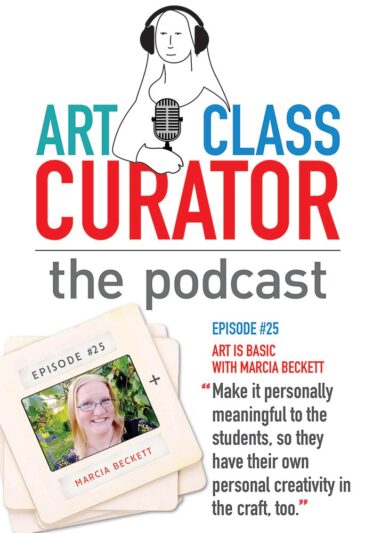
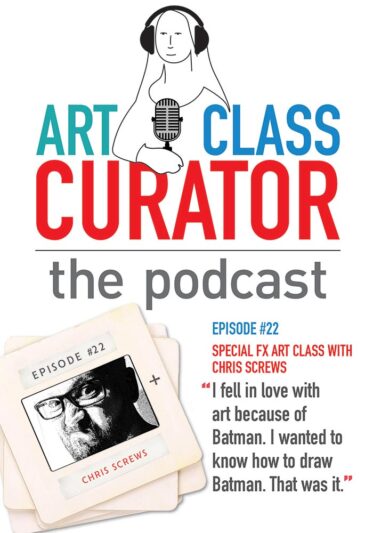
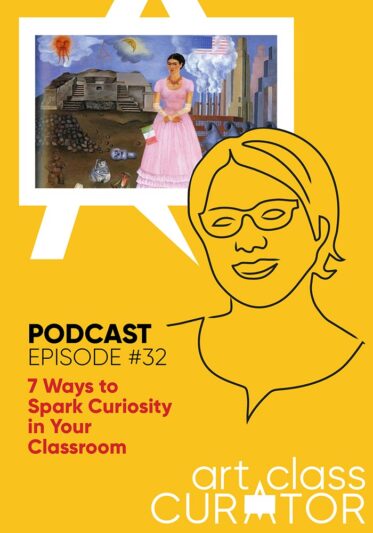
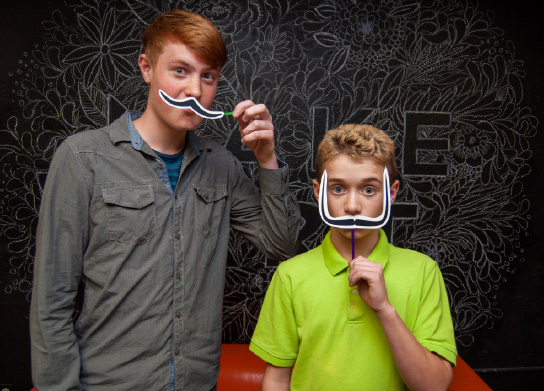
Leave a Comment